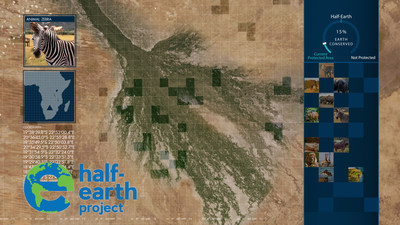The Half-Earth Project is 'unlocking a new era in data-driven conservation.'
DURHAM, N.C., March 5, 2018 — (PRNewswire) — The Half-Earth Project has launched online the first phase of their cutting-edge global biodiversity map. This unique, interactive asset uses the latest science and technology to map thousands of species around the world and illuminate where future conservation efforts should be located to best care for our planet and ourselves.
"The extinction of species by human activity continues to accelerate, fast enough to eliminate more than half of all species by the end of this century," said E.O. Wilson in the New York Times Sunday Review on March 3. "We have to enlarge the area of Earth devoted to the natural world enough to save the variety of life within it. The formula widely agreed upon by conservation scientists is to keep half the land and half the sea of the planet as wild and protected from human intervention or activity as possible."
Born from Wilson's book Half-Earth: Our Planet's Fight for Life, the Half-Earth Project is providing the urgently needed research, leadership and knowledge necessary to conserve half the planet's surface. The new map sits at the center of this effort.
"The Half-Earth Project is mapping the fine distribution of species across the globe to identify the places where we can protect the highest number of species," Wilson said. "By determining which blocks of land and sea we can string together for maximum effect, we have the opportunity to support the most biodiverse places in the world as well as the people who call these paradises home."
The Half-Earth Project is targeting completion of the fine-scale species distribution map for most known terrestrial, marine, and freshwater plant and animal species within 5 years.
"This mapping tool is unlocking a new era in data-driven conservation," said Paula Ehrlich, President and CEO of the E.O. Wilson Biodiversity Foundation and head of the Half-Earth Project. "It will provide the scientific foundation upon which communities, scientists, conservationists and decision-makers can achieve the goal of Half-Earth."
A $5 million leadership gift from E.O. Wilson Biodiversity Foundation board member Jeff Ubben and his wife Laurie will seed the second phase of the Half-Earth Project's mapping effort.
"Half-Earth can't wait. We have to work quickly and we need to be smart about how we do the work," said Jeff Ubben. "This map will give us the information we need to make strong conservation investments."
"Ed Wilson framed Half-Earth as a moonshot necessary to preserve the future health of our planet," Ehrlich said. "The investment in our work from Jeff and Laurie Ubben attaches rocket boosters to this moonshot."
For more information, contact Chris Heltne at the E.O. Wilson Biodiversity Foundation at cheltne@eowilsonfoundation.org or call 919.699.5486.
![]() View original content with multimedia:
http://www.prnewswire.com/news-releases/mapping-earths-species-to-identify-conservation-priorities-300607894.html
View original content with multimedia:
http://www.prnewswire.com/news-releases/mapping-earths-species-to-identify-conservation-priorities-300607894.html
SOURCE E.O. Wilson Biodiversity Foundation
| Contact: |
| Company Name: E.O. Wilson Biodiversity Foundation
|
